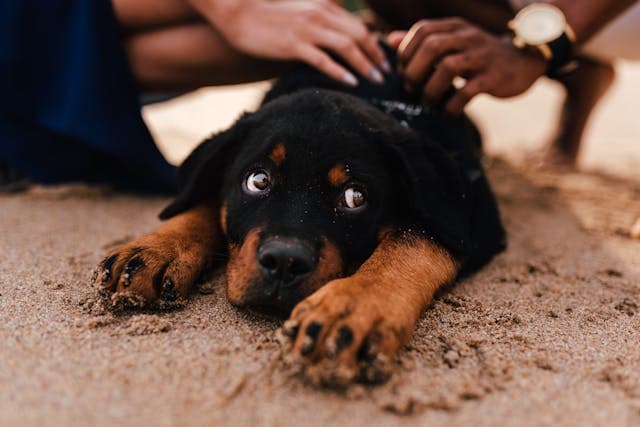
Canine Bloat

Our guide has been authored by qualified veterinarians, but should not be taken as substitute for medical advice or professional veterinary consultation. If your pet displays any unusual symptoms, we strongly advise seeking guidance from a veterinarian
Understanding Canine Bloat in dogs
Bloat, or gastric dilatation-volvulus (GDV), is a condition where the stomach becomes distended and expands due to the accumulation of gas (air, for example), causing pressure on the blood vessels along the stomach wall and the spleen. In severe cases, gas accumulation may cause the stomach to rotate in a twisting motion around its axis, known as volvulus. This movement generates pressure on the diaphragm, which is adjacent to it, as well as on central blood vessels responsible for supplying blood to the abdominal organs. From that moment on, within minutes, a state of shock may develop due to disruption of blood flow and multi-systemic damage, including disturbances in heart rate and respiratory failure.
Canine Bloat's Causes: Uncovering Triggers
It is not entirely clear what causes gastric dilatation-volvulus (GDV), but in large breed dogs, especially those with a deep-chested conformation, there is a higher risk of gas accumulation in the large stomach. In most cases, it occurs after rapid eating of a large amount of food or following eating too close to vigorous physical activity (before or after). There is also a strong genetic predisposition.
 Recognizing Canine Bloat: Signs and Symptoms
Recognizing Canine Bloat: Signs and Symptoms
- Restlessness and discomfort
- Bloated abdomen: a clear sign, but not always easy to discern, especially in muscular dogs or those with thick fur.
- Breathing difficulties: with a muffled pulse.
- Attempts to vomit unsuccessfully: there will usually be little to no stomach content since the stomach is blocked.
- Increased drooling
- Loss of appetite
In more severe cases or in the absence of treatment, disturbances in heart rate, apathy, and even systemic collapse may develop.
 Canine Bloat Diagnosis: How it's Identified
Canine Bloat Diagnosis: How it's Identified
Clinical examination by the veterinarian will assess the general systemic condition of the dog (usually arriving in a state of shock), feeling the abdominal area to determine if the stomach is full of gas, followed quickly by X-rays when the dog is lying on its side. In the case of GDV, a clear X-ray is usually obtained showing a distended stomach with gas, along with a characteristic appearance of rotation. One of the important goals of the examination is to differentiate between stomach distention alone, which is an uncomfortable but usually non-life-threatening condition that does not require surgery, and GDV, which requires emergency surgery.
 Treating Canine Bloat: Options and Approaches
Treating Canine Bloat: Options and Approaches
Gastric dilatation-volvulus (GDV) is an emergency condition that requires urgent medical intervention:
- In the first stage, action is taken to relieve the air in the stomach, reducing pressure, along with stabilizing the overall physical condition. Even before surgery begins, attempts are made to puncture the air using a needle inserted through the body wall into the stomach, while the dog receives rapid intravenous fluid therapy containing both pain-relieving drugs and drugs to prevent life-threatening rhythm disturbances.
- In the second stage, after initial stabilization and sedation, the dog is anesthetized (this is, of course, a high-risk anesthesia, so it is important to stabilize the condition beforehand and to perform careful monitoring by a skilled team during anesthesia). If there is still a large amount of gas in the stomach, an attempt is made again to empty it using a stomach tube inserted through the mouth.
- After stabilization and anesthesia, the dog undergoes surgery in which the stomach is returned to its original position and secured with sutures to adjacent muscles in the body wall to prevent recurrence of the condition. During surgery, the condition of the stomach wall, spleen, and adjacent organs is checked for damage. In a significant number of cases, the blood supply to those organs may be compromised, leading to the development of necrosis.
Canine Bloat: Surprising Facts

Dogs weighing over 100 lbs. have a 20% higher chance of developing GV. This risk increases significantly after the age of 7 and is twice as high among males compared to females.

Dogs that have experienced GDV in the past are at higher risk of experiencing it again in the future.

Even if medical attention is given promptly, the mortality rate due to GDV among dogs is 25%-30% - meaning roughly 1 in 4 dogs won’t survive it.
 Vet's Tip: Dealing with Canine Bloat
Vet's Tip: Dealing with Canine Bloat
Divide your dog’s daily meal into two halves to be served throughout the day, and ensure that his eating pace is not too fast. Also, provide reasonable time gaps between vigorous physical activity and meals, and pay attention to specific signs of distress in your dog. Remember that this is a life-threatening condition that requires urgent veterinary intervention, as it can deteriorate rapidly into a state of systemic collapse.




Price Tag

Latest in Research and Treatments
A new study found that dogs suffering from gastric torsion have a higher level of a hormone called copeptin released in response to stress or dehydration. This means that it may be possible to use it as a biological marker for early identification, distinguishing between dogs suffering from gastric torsion and those suffering from other digestive problems. Early diagnosis is especially important in this case because it is associated with a better prognosis.
dogs breeds Prone to Canine Bloat
Did you know?
Enrolling in Animalia Pet Insurance
while your pet is healthy is a wise decision.
Waiting until a disease develops means it won't be covered.







